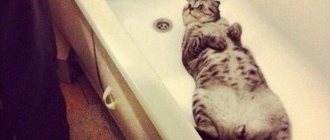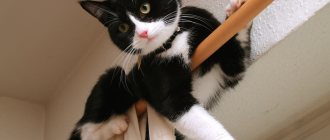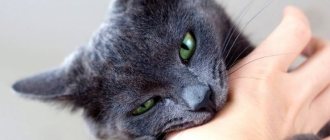Quiet rustles and clanking of dishes at night. The unexpected loss of household items, or the appearance of other people's things in the house can raise a lot of questions in any family. What is this? Ghosts? Brownies? Harmful neighbors? What are you, don’t be so scared. Behind all this could be none other than a cute, fluffy and absolutely harmless, at first glance, domestic cat. But how to stop a cat from stealing food from the table?
Cat theft is well known. But there is an opinion that only outbred and poorly raised cats steal. And if a purebred cat is caught red-handed stealing, the owners begin to suspect that the cat, who is not purebred at all, is stealing. The owners of even a pet picked up on the street, but lovingly nurtured, may come to the conclusion that nothing can correct the genes, or they begin to reproach themselves for shortcomings in upbringing.
Is it so? Any animal psychologist will tell you - no. In fact, theft from cats cannot be given any unambiguous assessment. There can be many reasons, and in some cases theft can be dealt with using fairly simple methods that will be discussed in this article. In others, you will have to put up with thefts, trying to minimize the damage, both for yourself and for your pet. So, let's discuss the first question.
What and why do cats steal?
First, let's break down cat theft into two categories: food theft and item theft.
As a rule, cats steal food when they want to eat. Very simple, isn't it? Of course, many owners claim that the cat eats enough (in their opinion), so there is no excuse for such theft. This is what owners think, but obviously not cats. By the way, a cat can really steal even with normal nutrition, and the reason in this case is banal curiosity.
Think for yourself, which of us, accustomed to borscht and porridge since childhood, would refuse to try, say, lasagna, cheesecake or parfait. And would you really, having never tried them, be able to calmly move away from the table where all this mysterious deliciousness stands? Believe me, a cat can’t either. After all, for him, food from the master’s table seems like something simply delicious and mysterious, which is definitely worth trying. And if the test showed that it was tastier than his food, then it is not surprising that the raids will continue. After all, not only people can be considered gourmets. A considerable part of them are also among the baleen striped ones. By the way, if, in the above example, a person can be protected from theft by ethical considerations, then cats do not have them and, in their essence, cannot have them.
Hunting instinct
Cats by nature are predatory animals and natural hunters. Even well-fed pets are no exception. At home, the need to realize instincts, practice and train hunting skills can make them cunning and dexterous thieves. This can happen if:
- they lack activity, they run and jump a little;
- they do not receive rewards (loot) after playing.
The role of prey is given to food left unattended. The theft is carried out in the form of a game and consists of the following stages:
- tracking;
- ambush;
- attack;
- eating.
Everything is like that of predatory animals in the wild.
Need: more time to play active games. At the end, offer a treat (prey).
Three reasons for stealing things
But, if the theft of food can be at least somehow justified, then the theft of things may certainly seem like something unhealthy. And again wrong. The reasons for such cat theft, in fact, are also quite simple and understandable.
Hunt replacement
Such non-standard behavior can become a substitute for a full-fledged hunt for a cat. Imagine how many emotions a shaggy thief can get while getting things that he doesn’t actually need. What can I say, for the sake of adrenaline, people don’t even do such things.
The desire to get what the owners do not give
The second reason may be that cats also have favorite things that slow-witted owners do not give of their own free will. You have to take risks and get the necessary toy yourself. For example, our cat will never calmly pass by a brush. It will pull. During cleaning, her hiding places with brushes are periodically discovered.
Please the owner
The third reason for theft is the most touching. This is the cat’s desire to somehow please his beloved owner or mistress. What should the poor fellow do if the mouse is not caught, and the birds do not allow themselves to be caught, and the cat feels that the gift is about to be torn off? Things obtained from neighbors will be very useful here. The example of Oscar the cat from England is widely known. Feeling immense gratitude to the owners who took him from the nursery, the cat simply showered them with gifts “borrowed” from the neighbors.
There were gloves, scarves, and even, for some reason, underwear that I liked. When Oscar's owners encountered this behavior, they were at first shocked, and having figured out the reasons for the strange behavior, they moved Murzik and left him with them.
Well, now, having figured out why cats steal, let's move on to specific actions to wean a pet from theft.
Uniformity of feed (lack of nutrients)
To keep your cat healthy, fit and active, her diet must be nutritious and balanced. Receiving monotonous food with the same set of nutrients, sooner or later the animal will begin to experience a lack of some of them.
To replenish the missing energy, the pet begins to look for additional food. And it doesn’t matter that the food of interest is outside the cat’s bowl.
Sources of essential nutrients can be:
- garbage dump;
- other people's food bowls;
- bin;
- household food (set table, meat or fish left in the sink to defrost, unsorted bags of groceries, refrigerator).
You need to: review your pet’s diet, diversify its diet, prepare and buy only high-quality food that includes a large complex of nutrients.
How to wean a cat from stealing
When faced with a cat stealing food, first make sure that he is actually eating well and in sufficient quantities. And then, you can learn to use simple techniques to instill a culture of behavior by studying and trying several ways to wean a cat from stealing. So, how to stop a cat from stealing food from the table?
Three Rules for Stealing Food
- The first, but very important rule, which is sometimes enough to cool a cat’s ardor, is to feed the cat well before you sit down at the table.
- The second rule will help us fight cat curiosity. If a cat begs for something from the table, offer him the most unappetizing dish, by cat standards. For example: a leaf of lettuce, a spoonful of the same porridge, or even a piece of meat, but pepper it first. Let the cat understand that what his owners eat is not tasty for him.
- The third important rule not only for raising a cat, but also for maintaining sanitation standards: do not leave food on the table. There is a refrigerator for this.
But, in principle, even if there is no food on the table, the cat should not climb on it. Therefore, if you see a mustachioed man in a restricted area, scare him. Spray with water, hiss or say sharply: shoot! If the cat does not react, do not let things take their course, remove the bully from the table and punish him.
Effective methods for weaning yourself from a bad habit
It is imperative to wean your cat from walking on the kitchen table and other surfaces in this room, and for several reasons. The first of these is hygiene. Nobody likes cat hair as a seasoning. In addition, the cat steps on the floor with its paws, climbs under sofas and on cabinets, where it is very dusty. And in general, many microorganisms that are relatively safe for cats can be harmful to people. No matter how clean she may be, her concepts of cleanliness are still different.
Secondly, household and cutlery may be unsafe for the animal itself. Thirdly, a cat, while living in a house, must still follow basic rules of behavior. Even if an animal considers itself the rightful owner of the apartment and the king of the world, it still must adhere to some rules of the hostel.
If time is lost, and the cat has acquired the habit of sitting, walking or sleeping on the table, then experts offer several tips for weaning the animal from incorrect behavior.
The next time you attack the table, you should use a toy weapon - a water pistol. If you don’t have one, you can use a spray bottle or any other device that sprays liquid. When the cat jumps to the surface, you need to spray water on it.
Most of these animals categorically do not like such influences. In order for it to understand what they want from it, the procedure needs to be repeated several times. That is, if a cat jumps off in response to a “shot” and leaves, then you need to detain it, put it back on the table and spray it with a pistol. Then she will understand that the owner disapproves of her behavior, and thus punishes her.
Another method to play on cats’ dislike of water is to place a baking tray filled with liquid on the table. The item should be secured well, for example, with double-sided tape, and water should be poured. Then you need to remove from the cat’s access area all objects that it can use as intermediate steps on the way to its goal. That is, move the chairs in, remove the shelves if possible. The cat will have to jump from the floor. Having raised a sheaf of spray, the cat will experience a number of unpleasant sensations, and is unlikely to risk repeating the maneuver. However, it is still worth repeating the experiment, in case the knowledge gained is not fixed in the cat’s memory at once.
Treating kitchen surfaces with strong-smelling substances is another effective way to wean your cat from walking on them. These animals have an extremely negative attitude towards strong odors, especially those emitted by acids. Spraying essential oils with citrus scents and treating surfaces with a solution of acetic acid will help rid your cat of a bad habit.
Another common method to stop a cat from jumping anywhere is to cover the surface with foil. The rustling of this material is extremely unpleasant and even scary for these animals, and the pet will quickly stop jumping into such a dangerous place, in its opinion.
Another option is tape. This is one of the most commonly suggested methods. By placing pieces of this sticky material on the table, you can permanently discourage the animal from jumping into an unauthorized place. An almost win-win option is foil and tape at the same time.
We stop stealing things
With regard to stealing things, everything is more complicated than with food. So, if you think that the cat is stealing out of boredom, there is only one way out: play with the purr more. If the cat prefers some specific things, then might it be advisable to buy the cat his set of toys?
Let him frolic to his health, and you won’t have to think about how to wean your cat from stealing things. Well, in the case of stealing out of gratitude, I’m afraid that nothing will be done. Just love your cat and appreciate his reciprocal love, even if shown in such an unconventional way.
Folk remedies
The most popular folk remedy is vinegar. It is diluted in a 1:1 ratio and the area where the animal shits is washed. It not only removes unpleasant odors, but also repels the pet. Some people prefer to use bleach or bleach. But, firstly, not all mustaches are repelled by this smell. Secondly, for people living in an apartment, frequent use of bleach is unlikely to be beneficial, especially for children.
A weak solution of potassium permanganate, iodine solution (a few drops per liter of water), and hydrogen peroxide are suitable for disinfection. A paste of baking soda and water removes odor well, and after drying it can be easily swept up or removed with a vacuum cleaner.
Electricity
It’s worth saying right away that this method should be used only as a last resort, when all others do not work. After all, this method is quite dangerous and can cause harm to the animal if used incorrectly.
You can buy a mat at large pet stores or online that gives a small electric shock when you stand on it. But this blow is safe for the animal. When the cat feels this, he obviously won’t want to experience it anymore, which means he won’t climb on the table. However, the mat should only be used under the supervision of the owner.
There are also similar collars that also give a small shock. Control is carried out using a remote control or an application on a smartphone.
Source
✅✅✅ Few people know for sure how to wean a cat from stealing food from the table. Most people either engage in assault or simply give up. ➤➤➤
Why the kitchen table attracts animals
How to stop a cat from climbing on the table
Having figured out the methods of influence that will help wean your pet from walking on the table, it is worth understanding why they generally like to be in territory that is forbidden to them. The answer to this question lies in several reasons.
Curiosity
First of all, the reason for such chaos is cat curiosity. This is an innate character trait, so the cat will always climb into all corners of the house, as well as pieces of furniture. New interesting objects that the owner brings home will always be the center of attention of the animal
The objects on the table will not be left out of attention either.
Curiosity attracts cats to the table
To prevent a curious animal from being interested in climbing onto the kitchen table, you just need to remove all objects from it and leave it completely empty.
Advice! It is worth pushing all the chairs around the table under the table.
Search for food
Cats love to steal food from humans. Everyone knows that instincts are developed not only in wild animals, but also in domestic cats, so they consider stolen food to be their rightful prey. You can combat this in the following way: after a meal, put all food in the refrigerator, carefully collect leftover food, wiping the surface.
The cat climbs onto the table for food
Desire to rest
Furry friends love to sleep where the aroma of food is present. Sitting on the tabletop, like on a bed, and stretching out to their full height, they feel quite comfortable. To avoid such arrogant behavior, you need to equip a special place for your pet where he will feel good and cozy.
Advice! Since cats like to climb higher, to enhance the effect, you can put a cat resting place, for example, on a nightstand.
Cat in a cozy lounger
Love for heights
Four-legged pets like to watch what is happening from above. They climb higher and from there they look at what is happening below. Basically, this behavior can be noticed when there are several animals living in the house.
In this case, the owner will come to the aid of a special shelf that needs to be hung in the kitchen. It will serve as an “observation post.” If a cat jumps on the table, you need to shush him and move him to a personal shelf.
Cats love to climb higher
Finding a warm place
During the cold season, cats are always looking for warm places for themselves. As you know, warm air rises, so animals consider a table an excellent place for a cozy pastime.
To keep your pet warm outside the kitchen countertop area, you need to build a hammock for him near the radiator or move a chair next to it
It is also necessary to remove the desk lamp and laptop from the table after using them, as they also emit heat, attracting unwanted attention.
Warm place for the cat
Hunting instinct
Cats are natural hunters. If the table is near the window, then the animal can sit on it to watch what is happening on the street through the window. Cats can follow a fly, a bird or the glare of the sun.
In this situation, it is necessary to curtain the window or act more radically and move the table to another place. There is another, more cunning option: you can hang a bird feeder opposite another window, thereby providing the animal with a new place to observe.
If you find out the answers to the questions why cats like to jump on the table and why it is dangerous, it will be easier to deal with this problem. A few simple ways will help you fight your pet’s bad habit. Having studied these methods, pet owners will be able to easily put all the tips into practice. You just need to be patient, spend a little time, and everything will definitely work out.
Unexpected fall
The method is somewhat inhumane, but one session may be enough for the cat to forget the way to the table. To carry out the plan, you will need a lightweight plastic tray.
The tabletop is furnished with “inconvenient” objects so that only one side remains free. Bottles and pots will come in handy as an impromptu fence. Place the tray on the free side, pushing it slightly beyond the edge of the tabletop. You can pour some water into the tray itself.
Further events can be predicted. The cat doesn't want to jump on the tray, but there is no choice, because the whole table is occupied. The animal jumps, knocking over the tray. Water pours onto the cat, and the container itself falls to the floor with a crash.
After such a procedure, the pet will not dare to explore the table for a long time. For greater effect, the grief tray can be left in sight for several days.











